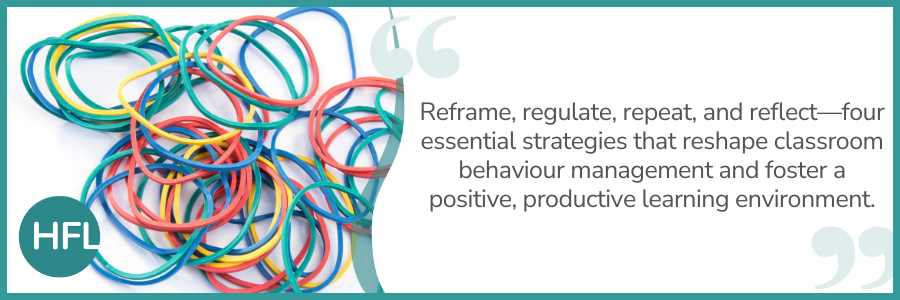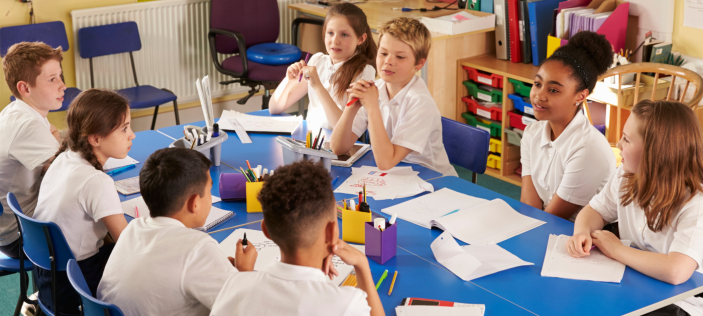
The topic of behaviour management can often be a challenging one for teachers and educators to discuss openly. There are numerous approaches, many of which are polarising, drawing deep lines in the sand and evoking strong reactions. Admitting that behaviour management can be difficult at any level is sometimes met with disapproval, as if there's an unspoken expectation that once you complete your BEd, PGCE, or equivalent qualification, you should instantly possess the skills to manage any behavioural issues you encounter—if only it were that simple!
The behaviour ‘landscape’ has shifted dramatically since I started teaching in the very early 2000s…pupils' behaviour is different, our communities are different and the way we respond is different.
Across the country, schools are working tirelessly to evaluate, review, and refine their behaviour management approaches. In Hertfordshire, many of our schools are nearing the completion of the HFL Education Behaviour Leadership Programme. However, embedding new approaches and ensuring consistency takes time—it's a gradual process that requires thorough groundwork before a new policy can truly make an impact. With this in mind, I wanted to share some key strategies and practices that have been invaluable to me over the years in managing behaviour and shaping my responses in the classroom.
Reframe:
Reframing or renaming behaviour can be a powerful tool for both understanding and managing it more effectively. By shifting our perspective, we can adopt a more positive and flexible mindset, which not only helps us understand the root causes of a pupil's actions but also allows us to identify potential routes to support them more effectively. The way we label behaviour profoundly influences how we respond to it. When we reframe our interpretation of a pupil's behaviour, we change the narrative, opening up new possibilities for intervention and support:
- They have an attitude problem - they don’t feel safe
- They can’t be bothered - they aren’t able to engage
- They are so attention seeking - they are attention needing
- They are having a meltdown - they are dysregulated
When we reframe behaviour as a moveable state—something fluid rather than fixed or permanent—we open ourselves to the possibility of influencing and shifting it. This perspective encourages us to move away from viewing behaviour as a personal flaw or an inherent characteristic and instead recognise it as a response to unmet needs or challenging circumstances.
Regulate:
Self-regulation and co-regulation are often discussed in schools as ways to support pupils who are emotionally heightened. But how often do we, as educators, consider our own self-regulation? Every day, those of us working in education face numerous situations that require us to activate and deploy strategies for managing our own emotions. Most of the time, we handle this well, but we’re human, and there are moments when our strategies don't kick in quickly enough or simply fail us.
Take a moment to reflect on the behaviours that really get under your skin, that trigger you or push your stress levels to the brink. It might be pupils mumbling under their breath, rolling their eyes, not saying please or thank you, or talking over you. For me, it was the sound of pencils being tapped on tables. It drove me to distraction. Were my pupils doing it to disrupt my lesson or be disrespectful? No, they were using it as a self-regulation strategy to help them focus. And I needed them to focus, so how could I sanction them for it? I couldn’t. Instead, we wrapped elastic bands around the ends of the pencils, and everyone was happy—they could tap, and I didn't feel overwhelmed. It was a simple solution, but it had a significant impact on the harmony and learning in my classroom.
Repeat:
Repetition is one of the most powerful tools in your teaching toolbox. It not only reinforces expectations, routines, and boundaries but also creates a sense of psychological safety for your pupils. In today's classrooms, many of us are encountering a rising number of pupils experiencing anxiety, often rooted in early childhood experiences or emerging additional needs. For these pupils, psychological safety is key to creating a predictable environment—one where potential outcomes are clear, and even if the wrong choice is made, the consequences are understood and expected.
Shifting behaviour patterns doesn’t happen overnight. However, the continuous, drip-fed repetition of expectations, routines, and boundaries is crucial in supporting this change. By consistently repeating what positive behaviour “looks like” in your setting, and regularly practising and reinforcing these behaviours, you help pupils internalise these expectations. This repetition not only creates a structured learning environment but also builds pupils' confidence, reassuring them that they know what is expected and how to succeed within those expectations.
Reflect:
"Put it in the room and walk around it." This is a phrase I once heard from a psychologist, and it has stayed with me ever since. While I am in no way suggesting that a pupil's behaviour should be blamed on staff, it is crucial for us, as educators, to reflect on, review, and question our role in any incident. We must be willing to ask ourselves the potentially uncomfortable question: What could I have done differently?
In many schools, especially those that use therapeutic and relational approaches to behaviour management, we encourage our pupils to reflect on their actions and consider what they could have done and will do differently. If we ask this of our pupils, it is only fair that we hold ourselves to the same standard. After all, adult intervention in an incident can lead to one of three outcomes: it can either calm and de-escalate the situation, have no impact, or escalate it further. It is essential for us as practitioners to reflect on every incident and identify what went well. What strategies did we use to successfully navigate the situation to a positive outcome? Conversely, we also need to consider what might have acted as a catalyst for further escalation. This reflection requires honesty and accountability. We must be prepared to acknowledge our role in the outcome and ensure that we learn from each incident.
Just as we review and refine our teaching after a lesson observation, we must apply the same level of scrutiny to our behaviour management practices. This is how we truly refine our craft. By consistently reviewing our involvement, actions, and the outcomes of incidents, we can better understand the impact we have on the dynamics of our classrooms.
Navigating the complexities of behaviour management requires us to acknowledge that both pupils and educators are continually growing and adapting. By embracing strategies like reframing, regulating, repeating, and reflecting, we not only refine our own practice but also help foster a more positive and supportive school environment. If you’re seeking expert guidance, support, or tailored training to enhance behaviour management in your school, don’t hesitate to get in touch.



